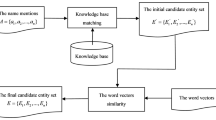Abstract
Entity linking has received much more attention. The purpose of entity linking is to link the mentions in the text to the corresponding entities in the knowledge base. Most work of entity linking is aiming at long texts, such as BBS or blog. Microblog as a new kind of social platform, entity linking in which will face many problems. In this paper, we divide the entity linking task into two parts. The first part is entity candidates’ generation and feature extraction. We use Wikipedia articles information to generate enough entity candidates, and as far as possible eliminate ambiguity candidates to get higher coverage and less quantity. In terms of feature, we adopt belief propagation, which is based on the topic distribution, to get global feature. The experiment results show that our method achieves better performance than that based on common links. When combining global features with local features, the performance will be obviously improved. The second part is entity candidates ranking. Traditional learning to rank methods have been widely used in entity linking task. However, entity linking does not consider the ranking order of non-target entities. Thus, we utilize a boosting algorithm of non-ranking method to predict the target entity, which leads to 77.48% accuracy.
Access this chapter
Tax calculation will be finalised at checkout
Purchases are for personal use only
Preview
Unable to display preview. Download preview PDF.
Similar content being viewed by others
References
Johnson, R., Zhang, T.: Learning nonlinear functions using regularized greedy forest. arXiv preprint arXiv:1109.0887 (2011)
Friedman, J.H.: Greedy function approximation: A gradient boosting machine. Annals of Statistics, 1189–1232 (2001)
Chang, J.T., Schütze, H., Altman, R.B.: Creating an online dictionary of abbreviations from MEDLINE. Journal of the American Medical Informatics Association 9(6), 612–620 (2002)
Han, X., Zhao, J.: NLPR_KBP in TAC 2009 KBP Track: A Two-Stage Method to Entity Linking. In: Proceedings of Test Analysis Conference (TAC 2009) (2009)
Nadeau, D., Turney, P.: A supervised learning approach to acronym identification (2005)
Zhang, W., Sim, Y.C., Su, J., Tan, C.L.: Entity linking with effective acronym expansion, instance selection and topic modeling. In: Proceedings of the Twenty-Second International Joint Conference on Artificial Intelligence, vol. 3, pp. 1909–1914 (2011)
Liu, X., Li, Y., Wu, H., Zhou, M., Wei, F., Lu, Y.: Entity linking for tweets. In: Proceedings of the 51th Annual Meeting of the Association for Computational Linguistics. Association for Computational Linguistics (2013)
Han, X., Sun, L., Zhao, J.: Collective entity linking in web text: A graph-based method. In: Proceedings of the 34th International ACM SIGIR Conference on Research and Development in Information Retrieval, pp. 765–774 (2011)
He, Z., Liu, S., Li, M., Zhou, M., Zhang, L., Wang, H.: Learning entity representation for entity disambiguation. In: Proc. ACL 2013 (2013)
Milne, D., Witten, I.H.: Learning to link with wikipedia. In: Proceedings of the 17th ACM Conference on Information and Knowledge Management, pp. 509–518 (2008)
Quinlan, J.R.: C4. 5: programs for machine learning. Morgan Kaufmann (1993)
Zheng, Z., Li, F., Huang, M., Zhu, X.: Learning to link entities with knowledge base. In: Human Language Technologies: The 2010 Annual Conference of the North American Chapter of the Association for Computational Linguistics, pp. 483–491 (2010)
Shen, L., Joshi, A.K.: Ranking and reranking with perceptron. Machine Learning 60(1-3), 73–96 (2005)
Cao, Z., Qin, T., Liu, T.-Y., Tsai, M.-F., Li, H.: Learning to rank: From pairwise approach to listwise approach. In: Proceedings of the 24th International Conference on Machine Learning, pp. 129–136 (2007)
Joachims, T.: Optimizing search engines using clickthrough data. In: Proceedings of the Eighth ACM SIGKDD International Conference on Knowledge Discovery and Data Mining, pp. 133–142 (2002)
Freund, Y., Iyer, R., Schapire, R.E., Singer, Y.: An efficient boosting algorithm for combining preferences. The Journal of Machine Learning Research 4, 933–969 (2003)
Burges, C., Shaked, T., Renshaw, E., Lazier, A., Deeds, M., Hamilton, N., Hullender, G.: Learning to rank using gradient descent. In: Proceedings of the 22nd International Conference on Machine Learning, pp. 89–96 (2005)
Xu, J., Li, H.: Adarank: a boosting algorithm for information retrieval. In: Proceedings of the 30th Annual International ACM SIGIR Conference on Research and Development in Information Retrieval, pp. 391–398 (2007)
Author information
Authors and Affiliations
Editor information
Editors and Affiliations
Rights and permissions
Copyright information
© 2014 Springer-Verlag Berlin Heidelberg
About this paper
Cite this paper
Zou, X., Sun, C., Sun, Y., Liu, B., Lin, L. (2014). Linking Entities in Tweets to Wikipedia Knowledge Base. In: Zong, C., Nie, JY., Zhao, D., Feng, Y. (eds) Natural Language Processing and Chinese Computing. NLPCC 2014. Communications in Computer and Information Science, vol 496. Springer, Berlin, Heidelberg. https://doi.org/10.1007/978-3-662-45924-9_33
Download citation
DOI: https://doi.org/10.1007/978-3-662-45924-9_33
Publisher Name: Springer, Berlin, Heidelberg
Print ISBN: 978-3-662-45923-2
Online ISBN: 978-3-662-45924-9
eBook Packages: Computer ScienceComputer Science (R0)




